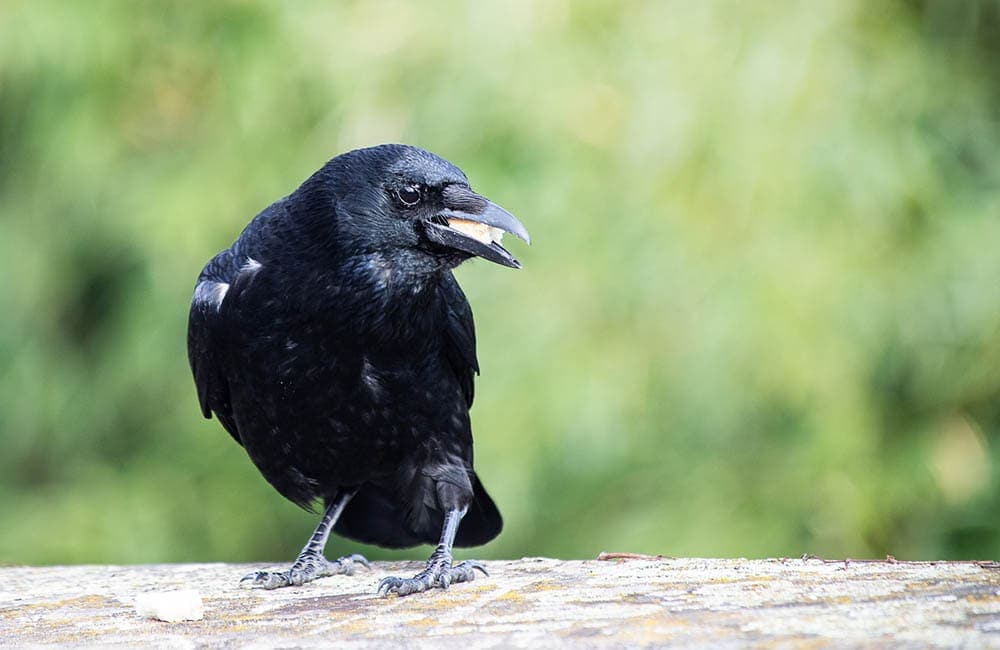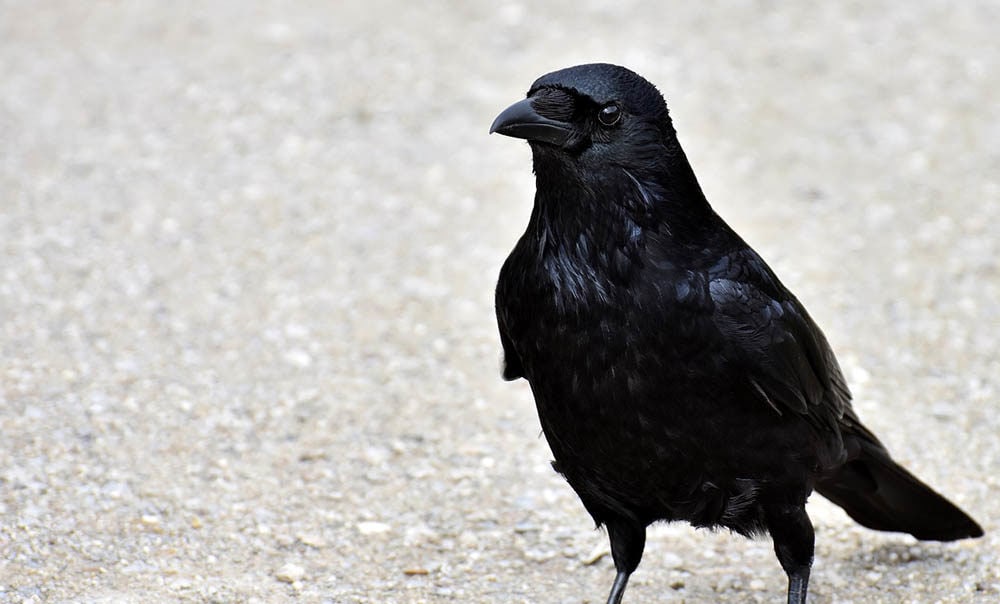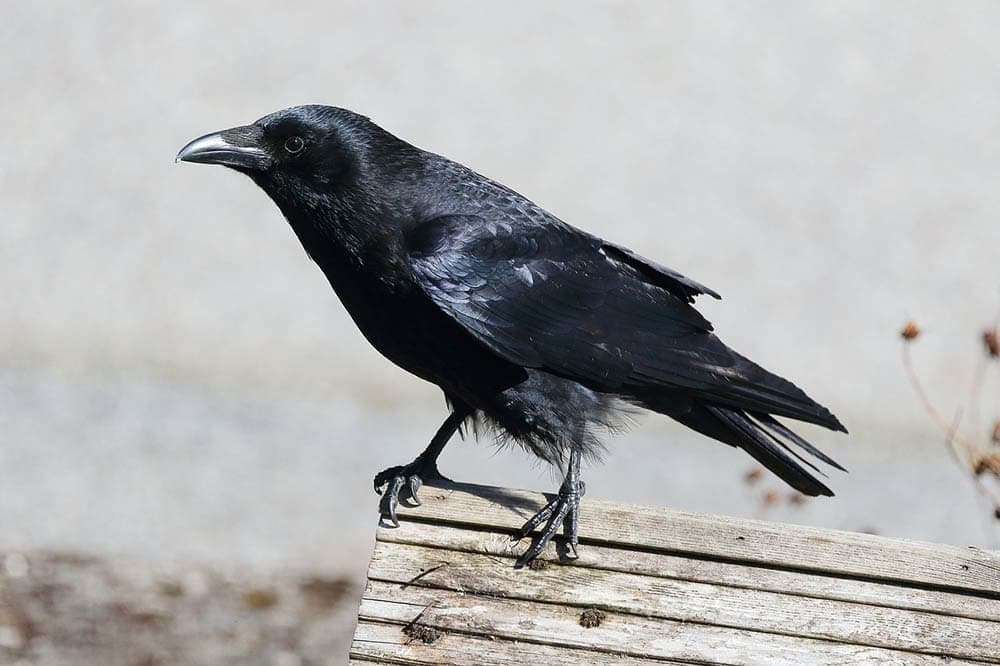What Do Crows Eat? The Crow Diet Explained
Last Updated on

Crows have quite the reputation for being mischievous birds who scavenge. In some cultures, these shiny, black fowl are considered bad omens. In other parts of the world, they are believed to unlock ancient mysteries. But one thing is for sure—you’re likely quite familiar with this species.
We’ve all seen crows hanging out on the side of the road, in parking lots, or out in a field. It’s not unusual to see crows feasting on or pecking at a variety of items—from roadkill to plastic bags. So, what exactly is a crow’s standard diet?

All About Crows
| Scientific Name: | Corvus |
| Family: | Corvidae |
| Lifespan: | 7-8 years |
| Wingspan: | 2.8-3.3 feet |
| Length: | 16-21 inches |
| Weight: | 0.7-1.4 pounds |
The crow is closely related to ravens. At first glance, the two might be indistinguishable to the naked eye. However, ravens are typically much larger than crows. Ravens usually inhabit sections of western and northern parts of North America, whereas crows live all over.
There are two main types of crows: the carrion and American—the difference? American crows are found (you guessed it) in America, while carrion crows are throughout most of Europe and Asia.
Crows are one of the smartest birds in the world, stunning experts with their problem-solving abilities and impeccable memories. Many studies have been performed on these magnificent creatures, finding that they might possess intelligence close to that of primates.

Crow Habitat
If you’re out and about, you might see at least one crow on your outing if you’re beyond city limits (or even within.) These birds are plentiful with increasing populations throughout the United States.
However, naturally, these birds inhabit agricultural and grasslands since they have the most abundant food source for them. Crows also thrive well in populated areas, since there are a lot of scraps to feast on.
These birds are widely revered for being secret nesters—they are even capable of making decoy nests. Crows make their nests in the crotch of tree trunks, typically in deciduous trees. Although, if none of these trees are available, they will house in other varieties.
Crow Diet
Crows are opportunistic and versatile eaters. These birds are omnivorous, meaning they feast on both plant and animal matter to survive. Since they eat practically anything they can find, their diets mostly consist of:
- Earthworms
- Spiders
- Frogs
- Snakes
- Insects
- Shellfish
- Eggs
- Baby birds
- Seeds
- Berries
- Fruit
- Garbage
- Carrion
Yes, the carrion crow didn’t get their name as just a clever hook—these birds will absolutely feast on the dead. While it isn’t always their primary source of sustenance, they will eat whatever is readily available to them.
If you’ve seen them sifting through garbage, you can bet they’re looking for snacks. However, it’s very common for them to search for nesting materials this way, too.

Crows Communication Systems
If you’ve ever seen a crow picking at something dead on the side of the road, you might notice how they fly away long before your car reaches them. The likelihood of catching a crow off guard, even at high speeds, is incredibly rare.
So, why is this? Crows are excellent communicators with very complex social structures. They have very tight-knit units that often hunt together in small groups of threes—sometimes more or less.
It isn’t unusual to see one crow up in a tree, acting as a lookout while their mates are enjoying a freshly killed opossum. If danger is imminent, they have no problem sounding the alarm, letting their comrades know.
Crows Sometimes Feed Each Other
Because of their closeness with their family unit, they take care of one another. When a mother crow is sitting to incubate her eggs, the dad will go out and retrieve food for the both of them.
Females spend over 90% of their time in the nest, so the males gather up what they can to make sure she is taken care of. The mated pair will usually stay together for life, though they sometimes mate with other crows.
Most of the time when you see crows feasting, they enjoy dining close together. They have no problem sharing the same dead squirrel or pecking over an area riddled with delicious bugs.

Feeding Crows
It isn’t uncommon to make friends with a whole murder of crows by feeding them. Crows remember who is nice and who isn’t—who is beneficial and who is dangerous to their wellbeing. Crows never forget a face.
So, if you’ve noticed crows around your yard or neighborhood, you can lure them in to befriend them with goodies. Before doing so, make sure these birds will stay safe and no threats are around your home that could cause them harm.
Crows like junk food, so just make sure the snacks you feed them are yummy but also healthy. Many people who feed these flying friends choose menu options like:
- Cat or dog food
- Unsalted peanuts
- Eggs
- Fruit
- Vegetables
- Chicken
Once you have their attention with a snack of choice, create a feeding routine. A routine will establish constancy and trust with the animals. Once they know what you have to offer and when to expect you, they will be in your yard waiting for their daily treats.

In Conclusion
Crows are a species with voracious appetites, eating just about anything in front of them. This survival diet proves very well to keep the population up. After all, crows are highly dense and growing every year.
If you’re looking to befriend some crows, it shouldn’t be hard as long as you offer the right foods to keep them coming back. Crows are social and food motivated, so they will quickly pick up on the fact you’re a food source. Once they develop trust in you, they will never forget.
Featured Image Credit: Pixabay
About the Author Ashley Bates
Ashley Bates is animal writer and enthusiast who is currently studying the art of animal therapy. A mother to four human children— and 23 furry and feathery kids, too – Ashley volunteers at local shelters, advocates for animal well-being, and rescues every creature she finds. Ashley's mission is to create awareness and education about animals of all shapes and sizes to promote proper care and respect.
Related Articles:
What Is the Best Binocular Magnification for Hunting? Optical Features Explained
How to Clean a Refractor Telescope: Step-by-Step Guide
How to Clean a Telescope Eyepiece: Step-by-Step Guide
How to Clean a Rifle Scope: 8 Expert Tips
Monocular vs Telescope: Differences Explained (With Pictures)
What Is a Monocular Used For? 8 Common Functions
How to Clean a Telescope Mirror: 8 Expert Tips
Brightfield vs Phase Contrast Microscopy: The Differences Explained
